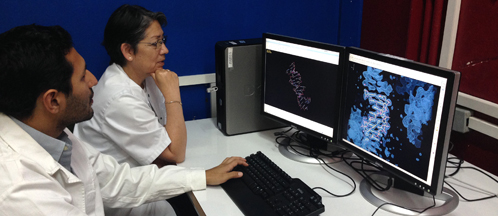ALBA Synchrotron

Researchers from the Universitat Politècnica de Catalunya - BarcelonaTech (UPC), the Institute of Medical Chemistry (IQM-CSIC) and the University of Glasgow have proved that the CD27 drug is a true alternative against malaria. They have analysed the crystalline structure of the DNA with the drug by performing X-ray diffraction experiments at the ALBA Synchrotron. This work has been published in the journal Acta Crystallographica D.
An international group of researchers, led by Lourdes Campos, from the Department of Chemical Engineering at the Universitat Politècnica de Catalunya - BarcelonaTech (UPC), has proved that the CD27 drug can be a reliable option against malaria. Researchers came to this conclusion after studying the 3D crystalline structure of the complex of DNA with the drug.
The CD27 drug is a complex synthesized by researchers led by Christophe Dardonville at the Spanish National Research Council's of the Institute of Medical Chemistry (IQM-CSIC), in Madrid, . "CD27 is chemically related to diamidines – molecules with two amidines – and has previously been used with success in other Trypanosoma species that produce the "sleeping sickness" in Africa and Chagas disease in South America", says Lourdes Campos.
Results show how the CD27 drug completely covers the minor groove of the DNA, preventing the typical development of the parasite and causing its death.
This research helps to understand this family of compounds and may significantly contribute to the development of new more effective drugs against malaria.

In the image, the drug CD27 completely covers the minor groove of the DNA complex.
Obtaining the DNA crystal
Once the samples of the drug were validated by Harry P. De Koning, researcher at the University of Glasgow, they were sent to the UPC research group in Crystallography, Structure and Function on Biological Macromolecules (MACROM), led by Lourdes Campos. For over a year, the group has been working to obtain the crystalline structure of DNA.
Obtaining a DNA crystal is a multiparametric process – it requires different variables – and, before obtaining a DNA crystal with the drug, several tests under different conditions are required. The crystal must present a very high molecule order in the crystalline network, as this is essential for solving the tridimensional structure of the complex. "Obtaining a good crystal is a long and hard task and it requires the collaboration of groups from different disciplines. With the help of synchrotrons like the ALBA, science can make a big step forward in comparison with the methods available 20 years ago", says Lourdes Campos.
In the next phase, researchers analysed the crystals of the complex of DNA with the drug using X-rays at the XALOC macromolecular diffraction beamline of the ALBA Synchrotron. X-rays, when they pass through the crystal and diffract, project images of spots which, after mathematic analysis, can solve the tridimensional structure of a molecule. When MACROM researchers solved the 3D structure, they identified the details of CD27's structure, enabling the drug to recognise the regions of DNA covering the minor groove and preventing the development of the parasite. At the same time, these studies contribute to a rational design of new drugs, bearing in mind the molecular interactions caused by CD27.
Results of this research have been validated and deposited at the Protein Data Bank, a 3D database of proteins and nucleic acids, and published in the journal Acta Crystallographica D.
The drug is patent-free and can be produced by any pharmaceutical company interested in its development.
Malaria, responsible for more than one million deaths every year
Malaria is an infectious disease caused by a parasite of the Plasmodium genus that is transmitted by a mosquito bite. It deeply affects African countries, although it is also present in some areas of Latin America and Asia (with an estimated at-risk population of 3,4 billion, according to the World Health Organization). It is thought that malaria causes more than one million deaths every year and the parasite's resistance to existing drugs is an obstacle in the treatment of the disease.


Researchers of the Universitat Politècnica de Catalunya - BarcelonaTech (UPC) analysing the crystal structure of DNA with the drug CD27.
Reference: "In and out of the minor groove: interaction of an AT-rich DNA with the drug CD27" Francisco J. Acosta-Reyes, Christophe Dardonville, Harry P. de Koning, Manal Natto, Juan A. Subirana and J. Lourdes Campos. Acta Crystallographica Section D Biological Crystallography 70 1614-1621